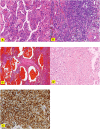Correlation Between Pulmonary Sclerosing Pneumocytoma Features and MSCT Imaging Manifestations in 34 Patients: Implications for Precision Medicine
- PMID: 33816530
- PMCID: PMC8012803
- DOI: 10.3389/fmed.2021.650996
Correlation Between Pulmonary Sclerosing Pneumocytoma Features and MSCT Imaging Manifestations in 34 Patients: Implications for Precision Medicine
Abstract
Objective: To identify and analyze the multi-slice computed tomography (MSCT) imaging manifestations and clinicopathological features of PSP to improve the preoperative and intraoperative diagnosis of the disease. Method: This was a retrospective study conducted on the imaging and clinicopathological data of the PSP patients treated in two major hospitals in China from October 2001 to December 2019. The locations of lung lesions, clinical symptoms, surgical complications, MSCT imaging features, and the corresponding relationship with clinicopathological features were assessed. Then, a new diagnostic approach was defined and used to train imaging and pathological doctors (experimental group). Then, the diagnostic accuracy of the experimental group was evaluated in preoperative and intraoperative diagnosis of PSP. Results: Thirty-four PSP cases were analyzed (mean: 51.42; range: 39-69 years old). The peripheral type was more common, while 92% of the lesions located in the middle lobe of the right lung and the lower lobe of bilateral lungs. The shortest lesion edge-pleura distance ranged 0 to 30 mm and 46% of the lesions (16/34) were attached to the pleura, 62% (21/34) located at 0-5 mm, 92% (31/34) within 20 mm from the pleura. Diameters of the lesions ranged 8.58 to 68.41 mm, while most of them were 20-40 mm. All lesions showed enhancement, and 97% (33/34) were unevenly enhanced. PSP volume was negatively correlated with the total degree of enhancement (r = -0.587, p < 0.01), and the volume difference between the obvious enhancement zone and the slight enhancement zone (r = -0.795, p < 0.01). Welt vessel sign was observed in 61.7% (21/34) of cases, and none of welt vessels entered into the lesions. Vascular-like enhancement area inside the lesion showed no significant correlation with the welt vessels outside the lesion, and no case showed entrance of bronchus into the lesion. The trained experimental group showed significantly greater diagnostic accuracy than the control group. In particular, the accuracy rate of intraoperative frozen section diagnosis was 60% higher in the experimental group than the control group. Conclusion: PSP has characteristic imaging manifestations, which can be utilized to improve the preoperative and intraoperative diagnostic coincidence rate of PSP.
Keywords: diagnosis; image pathological control; multi-slice computed tomography; pathology; pulmonary sclerosing pneumocytoma.
Copyright © 2021 Xu, Wang, Xiong, Li, Luo, Xu and Min.
Conflict of interest statement
The authors declare that the research was conducted in the absence of any commercial or financial relationships that could be construed as a potential conflict of interest.
Figures




Similar articles
-
[Analysis of Clinical Characteristics of 35 Cases of Pulmonary Sclerosing Pneumocytoma].Zhongguo Fei Ai Za Zhi. 2020 Dec 20;23(12):1049-1058. doi: 10.3779/j.issn.1009-3419.2020.103.19. Zhongguo Fei Ai Za Zhi. 2020. PMID: 33357311 Free PMC article. Chinese.
-
Analysis of the clinical differentiation of pulmonary sclerosing pneumocytoma and lung cancer.J Thorac Dis. 2017 Sep;9(9):2974-2981. doi: 10.21037/jtd.2017.08.07. J Thorac Dis. 2017. PMID: 29221270 Free PMC article.
-
Magnetic resonance imaging findings of pulmonary sclerosing pneumocytoma: a case report and literature review.Front Oncol. 2023 Sep 1;13:1158328. doi: 10.3389/fonc.2023.1158328. eCollection 2023. Front Oncol. 2023. PMID: 37727218 Free PMC article.
-
Pulmonary sclerosing pneumocytoma and mortality risk.BMC Pulm Med. 2022 Nov 7;22(1):404. doi: 10.1186/s12890-022-02199-1. BMC Pulm Med. 2022. PMID: 36344955 Free PMC article. Review.
-
Pulmonary sclerosing pneumocytoma in an 18-year-old male patient: A case report and literature review.Medicine (Baltimore). 2020 Jun 26;99(26):e20869. doi: 10.1097/MD.0000000000020869. Medicine (Baltimore). 2020. PMID: 32590790 Free PMC article. Review.
Cited by
-
Giant pulmonary sclerosing pneumocytoma with potentially malignant biological behavior: a case report and literature review.Ann Transl Med. 2023 Aug 30;11(10):365. doi: 10.21037/atm-22-4049. Epub 2023 Jun 14. Ann Transl Med. 2023. PMID: 37675291 Free PMC article.
-
Giant Cystic Pneumocytoma in a Young Male: Rare Diagnostic Conundrum with Clinicoradiological and Histopathological Features.Indian J Radiol Imaging. 2024 Aug 26;35(1):192-195. doi: 10.1055/s-0044-1789244. eCollection 2025 Jan. Indian J Radiol Imaging. 2024. PMID: 39697513 Free PMC article.
-
Analysis of the value of enhanced CT combined with texture analysis in the differential diagnosis of pulmonary sclerosing pneumocytoma and atypical peripheral lung cancer: a feasibility study.BMC Med Imaging. 2022 Feb 2;22(1):16. doi: 10.1186/s12880-022-00745-1. BMC Med Imaging. 2022. PMID: 35105314 Free PMC article.
-
Characterization of Pulmonary Sclerosing Pneumocytoma Assessed by 18F-FDG PET/CT.Thorac Cancer. 2025 Jul;16(13):e70124. doi: 10.1111/1759-7714.70124. Thorac Cancer. 2025. PMID: 40623844 Free PMC article.
-
Central and peripheral pulmonary sclerosing pneumocytomas: multi-phase CT study and comparison with Ki-67.Radiol Oncol. 2023 Sep 4;57(3):310-316. doi: 10.2478/raon-2023-0042. eCollection 2023 Sep 1. Radiol Oncol. 2023. PMID: 37665739 Free PMC article.
References
-
- Liebow AA, Hubbell DS. Sclerosing hemangioma (histiocytoma, xanthoma) of the lung. Cancer. (1956) 9:53–75. - PubMed
-
- Devouassoux-Shisheboran M, Hayashi T, Linnoila RI, Koss MN, Travis WD. A clinicopathologic study of 100 cases of pulmonary sclerosing hemangioma with immunohistochemical studies: TTF-1 is expressed in both round and surface cells, suggesting an origin from primitive respiratory epithelium. Am J Surg Pathol. (2000) 24:906–16. - PubMed
-
- William D. WHO Classification of Tumors of The Lung, Pleura,Thymus and Heart. Lyon: lARC; (2015).
LinkOut - more resources
Full Text Sources
Other Literature Sources
Miscellaneous

